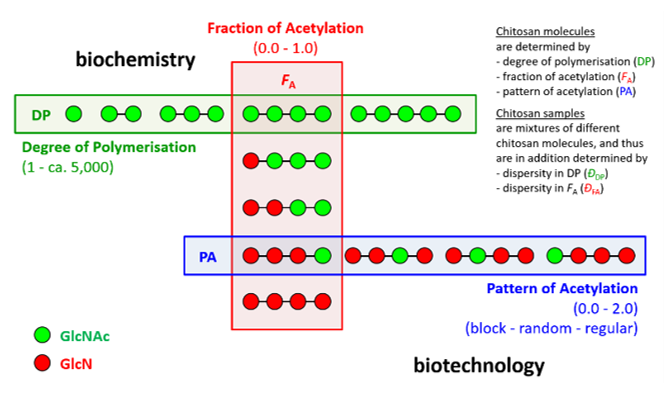
______________
______________

Chitosans are functional biopolymers with excellent physico-chemical material properties and versatile biological functionalities. Chitosans are linear co-polymers of more hydrophobic N-acetylglucosamine and more hydrophilic, in slightly acidic solutions positively charged glucosamine residues. The unique, partly polycationic and partly hydrophobic character of chitosans allows them to more or less specifically interact with partly hydrophobic and partly polyanionic biopolymers and biological structures, such as nucleic acids or proteins, phospholipid membranes or e.g. teichoic acids or pectins in cell walls, leading to a broad range of biological activities, such as antimicrobial, plant-strengthening, or wound-healing properties. However, in spite of more than twenty years of research, structure-function relationships of chitosans are still only poorly understood. Structurally, chitosan molecules are characterised by their degree of polymerisation (DP) and their fraction and pattern of acetylation (FA and PA). To fully characterise chitosan samples, additional parameters such as the dispersities in DP and FA (ĐDP and ĐFA) also need to be determined. While the original ‘first generation’ bulk chitosans were ill-defined mixtures of chitosans with unknown composition, today’s ‘second generation’ chitosans are well-characterised regarding their average DP and FA, and they are presumed to have random PA. Some of these chitosans are now commercially available, but their potential for the elucidation of structure-function relationships and the development of reliable applications is still far from being exploited fully. Recently, we have developed biotechnological tools to produce and characterise chitosans with different, non-random PAs and narrow ĐDP, which we consider to be the first examples of ‘third generation’ chitosans. In the ChitoCode project, we will use new analytical tools for the determination of ĐFA also, allowing us to produce chitosan samples defined in all five structural parameters (DP & ĐDP, FA & ĐFA, PA), including the first natural chitosans isolated from chitosan-producing organisms with intact, native PA. These will be screened for bioactivities in a broad set of bioassays, particularly regarding antimicrobial and different plant strengthening activities, and including transcriptomic and metabolomic analyses. We will make these chitosans available to other groups within and beyond the Codeχ consortium who have indicated their interest in using (some of) them in routine bioassays established in their labs, using different plant species, microorganisms, insects, algae, and human/mammalian cells and tissues. These will yield a large data set on chitosan structure-function relationships and will suggest cellular modes of actions which can then be investigated in follow-up projects by the Codeχ community.



University of Münster
Institute for Plant Biology and Biotechnology (IBBP)
Schlossplatz 8
48143 Münster
Germany

